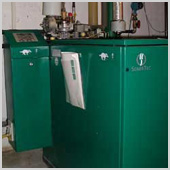
|
Combined Heat and PowerOverviewDecentralised solutions for the generation of power, in the form of combined heat and power (CHP) stations, allow the heat which is given off during power generation to be used. This can give an overall efficiency of over 80%. In other words, 80% of the primary energy input to the system can be put to good use, some as electricity, the rest as heat. This far exceeds the efficiency of decentralised power stations, which rarely permit the waste heat to be used. There is rarely an exact balance between the heat and power requirements from a plant. A distinction is, therefore, made between two types of operation: power-driven and heat-driven. In the case of power-driven CHPs, the prime consideration is the production of electricity when it is most profitable. In the case of heat-driven CHPs, the ecological considerations are at the forefront; electricity is only generated when all of the heat produced can be used. Driving wood-fired CHPs systems on a heat basis is definitely the best option: while power generation is not supported under the Feed-in Tariff (FIT), any heat used after the power-generation stage will benefit from the Renewable Heat Incentive (RHI). For smaller-scale wood-fired CHP systems, we consider systems based on the Organic Rankine Cycle (ORC) as the best option at the moment. In these systems, organic oils are heated to a high temperature. The evaporated oil drives a turbine connected to a generator. Some of the heat remaining after the power generation stage is passed to low-pressure water that is continuously circulated through a heat exchanger. (Some is used for pre-heating the working fluid.) The water is heated while performing the necessary function of condensing the working fluid. Related Case Studies |
Visit our French Site or German Site

